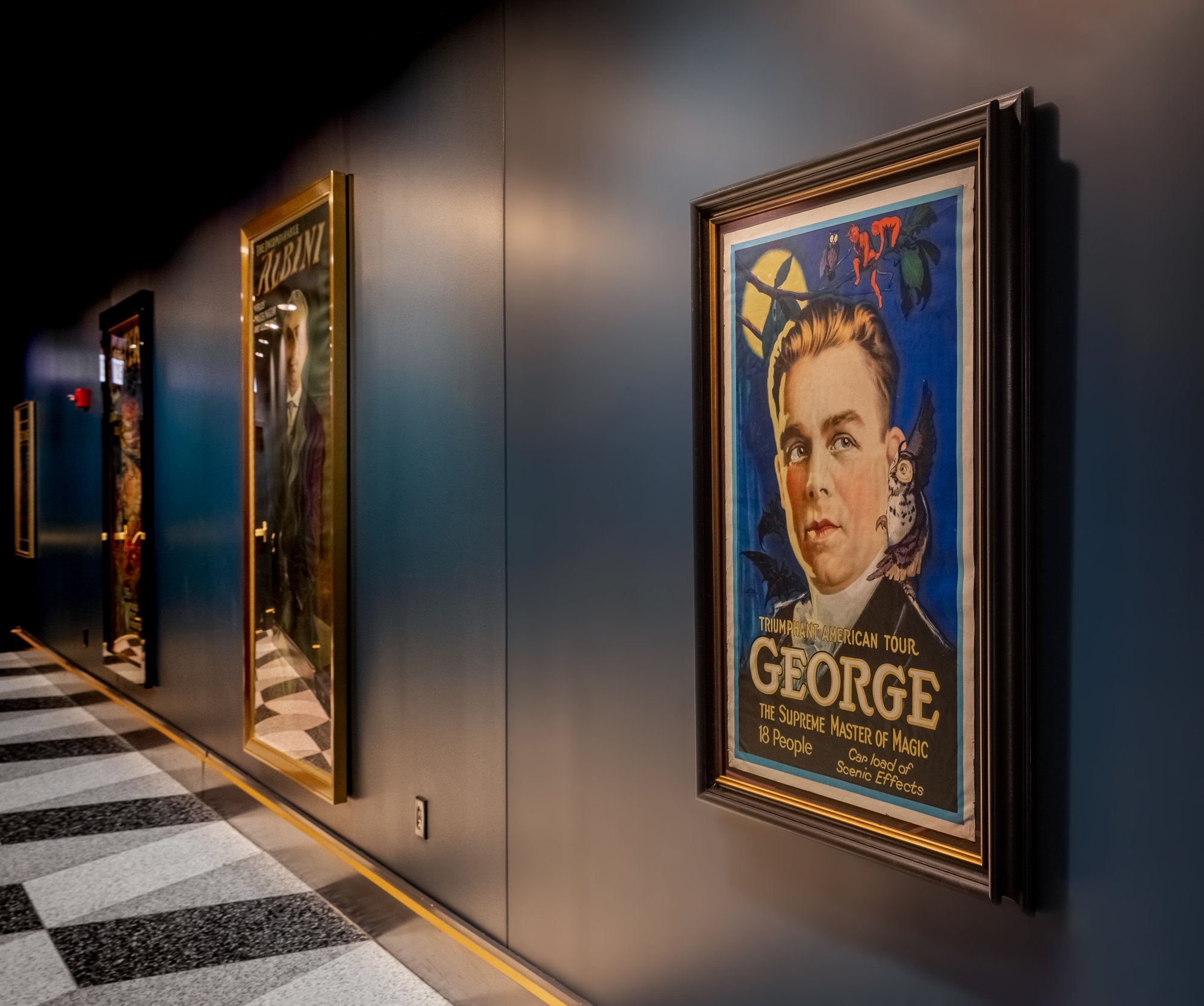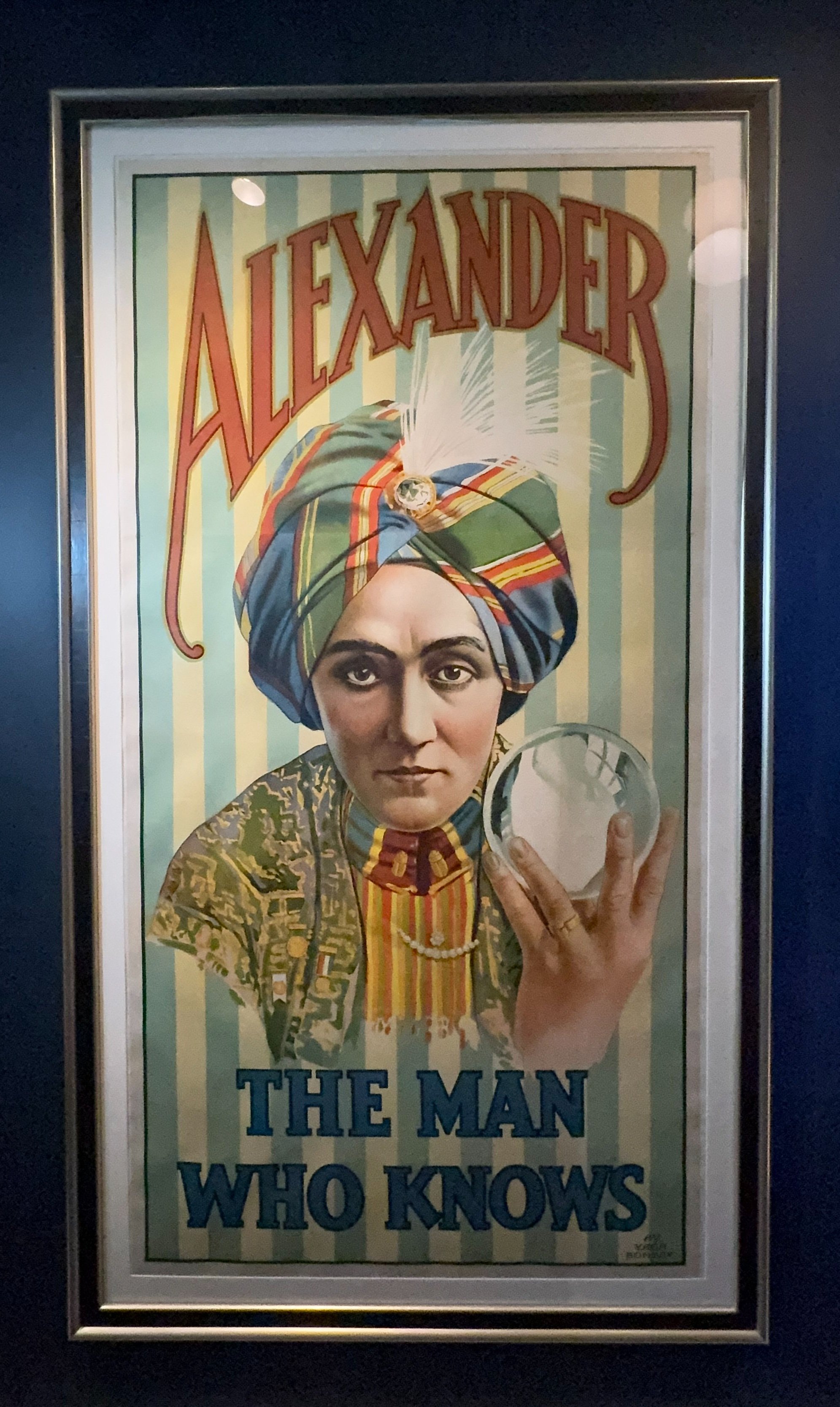
MAgicians A-c
ALBINI (Abraham Laski)
THE INCOMPARABLE Albini
American Showprint, Circa 1910.
There were two Albinis. The British one (Lieutenant Albini) and the Polish one, Abraham Laski. This is the Polish one, famous for opening a new deck of cards for each effect. By the end of his act, the stage was covered with discarded decks. He was also famous for the foul language he used on stage. He had a successful career on the Sullivan & Considine vaudeville circuit mainly because his courtroom testimony got John Considine out of a murder charge.
Want to learn more about the cantankerous Albini?
ALEXANDER (Claude Alexander Conlin)
Alexander, The man who knows
Unknown Printer, Circa 1920.
Claude Alexander Conlin was as much of a conman as he was a magician. This is one of the most popular and iconic poster images around. The printer is unknown, Alexander never went to India, and Av Yaga Bombay is fictional. The poster was printed in 1915. As the turbaned Man Who Knows, Alexander earned four million dollars over the course of a relatively short career during the 1920s.
BLACKSTONE, HARRY (Henry Boughton)
BLACKSTONE, THE GREATEST MAGICIAN THE WORLD HAS EVER KNOWN.
Unknown printer, Circa 1930.
From the Keneth Klosterman “Salon Du Magie” collection auction on Oct 30, 2021. Two-color one-sheet poster with Blackstone’s name encircled by a border of pitchfork-wielding demons. Uncommon.
BLACKSTONE, HARRY (Henry Boughton)
HArry Blackstone, The world’s Master Magician
James Upton Ltd., Circa 1915.
From early in Harry Blackstone's career, he was influenced by the #1 magician of the time, Harry Kellar, and his choice of poster motifs was no exception. The devils and imps seem to have stepped right out of Kellar's portrait and into Blackstone's. Over time, the Chicago-born Blackstone made a name for himself, creating a series of amazing and baffling effects. His Vanishing Birdcage, Dancing Handkerchief, and Floating Light Bulb are considered some of the greatest tricks in the history of the art.
Learn more about the “Grand old Man” Of Magic, HArry Blackstone Sr.
Bland, Will (Will, Enid, and Hilda Bland)
Will Bland and his magical Maids
Nicolitch, Circa 1917.
"The Australian Illusionist" Will Bland traveled around the world with his wife Enid and daughter Hilda. He was a highly regarded magician and wrote many articles for The Sphinx, a magic trade magazine. In the show, Enid assisted but also showed off her sleight-of-hand skills with the multiplying billiard balls. At eight years old, Hilda was billed as the youngest magician in the world, performing in all parts of the show.
BRINDAMOUR, GEORGE
The Great Brindamour
Strobridge Litho., 1903.
In the early 1900s, George Brindamour billed himself as the "Handcuff King," performing throughout America and abroad. He was a headliner for twenty-eight years. One of his favorite publicity stunts was to cause any church bell, picked by someone in the audience, to ring at a given time.
BRODIEN, MARSHALL
Assorted Ephemera
TV Magic Cards, TV Magic Cups, WGN ID, Cups and Balls
At 16, Marshall Brodien became the magician at the Riverview Amusement Park Sideshow. Later, he was their outside talker, sometimes called the "barker" by the uninitiated. Most famously for Chicagoans, Brodien was "Wizzo the Wizard" on the beloved children's program, The Bozo Show. Most famously outside Chicago, he pitched "TV Magic Cards" in nationwide commercials. He would expand the TV Magic line to include other decks and magic sets. At the end of 1999, the trade publication Magic Magazine named Marshall one of the most influential magicians of the 20th century. More than any other magician of those years, with his magic sets gifted on birthdays and Christmas, he influenced an entire generation of children to grow up to be magicians.
Want to learn more? Read a brief history of MAgic Posters.
BRUSH, EDWIN
Brush, The Mystic
Goes Litho., 1915.
Edwin Brush spent most of his career performing a full evening show under canvas on the Chautauqua circuit. He performed standard magic in an old-fashioned manner but enjoyed a very long career, performing up to his death at age 93. He was perhaps most famous for his trademark upside-down mustache.
Want to learn more about the life and career of Brush the Great?
CARTER THE GREAT (Charles Carter)
CARTER THE GREAT
Otis Litho., Circa 1926.
Charles Carter's elaborate illusion show quickly incorporated the sensational Sawing in Half illusion. Like his fellow magicians, Carter used a wooden box for the trick. This poster simplifies the trick to its essential dramatic elements: the magician, the saw, and the victim.
CARTER THE GREAT (Charles Carter)
CARTER THE GREAT - CALCUTTA
Eagle Litho., 1925
In 1925, Carter was in Calcutta when he received a letter from Illinois Litho stating that, because it was so difficult to get paid for their work, they hadn't shipped the thousands of posters that Carter desperately needed. This was the worst possible news for a touring show to receive. Carter was forced to abort this world tour, so he immediately had some posters printed locally so they could work a few dates on their way home.
CARTER THE GREAT (Charles Carter)
THE WORLD’S WEIRD WONDERFUL WIZARD
Otis Litho., 1926.
The lifeblood of a touring illusion show was the quality of its outdoor pictorial advertising. For the globetrotting Charles Carter, a good supply of posters was as valuable as his actual tricks. This poster is unsurpassed in its fantastic imagery and beautiful lithography. In 1926, Carter ordered 1,517 copies of this poster at 19 1/2 cents each, and additional orders followed over the next few years.
Learn more about the life and career of Carter the Great.
CHICAGO MAGIC ROUND TABLE
Chicago RoundTable
Salvatore Salva, 1965. Reprint. Gift from the Academy of Magical Arts
Chicago was a theater town, second only to New York in Vaudeville houses. Chicago was a nightclub town, a showroom town. Live entertainment was king. Chicago was the railroad center of America. Dozens of magicians made their homes in Chicago. Dozens more passed through, stopping for their regular local bookings. The Chicago Magic Round Table was originally established in 1929 as an informal gathering of these professional and amateur magicians, meeting daily for lunch at De Lazon's restaurant. Luminaries like Jay and Frances Marshall, Dr. Harlan Tarbell, Harry Blackstone Sr., and Werner Dornfield held court in the spirit of camaraderie and a shared love of the art of magic. Word quickly spread, and the Round Table became a headquarters for magicians in town.
The Comedians de Mephisto Company (Le Roy - Talma - Bosco)
Comedians de Mephisto Co. LeRoy-Talma-Bosco
Hamburg: Adolph Friedlander, 1905.
Originally developed by Servais Le Roy, with his wife Talma and Leon Bosco, The Comedians de Mephisto Co. Bosco is considered the first comedy magician on the record. This lithograph depicts one of LeRoy’s inventions, the Flying Visit illusion, a transposition effect. It once belonged to Edwin Dawes, famed magic author and collector.
Learn more about the genius of the Monarch of Mystery, Jean Henri Servais Le Roy.











